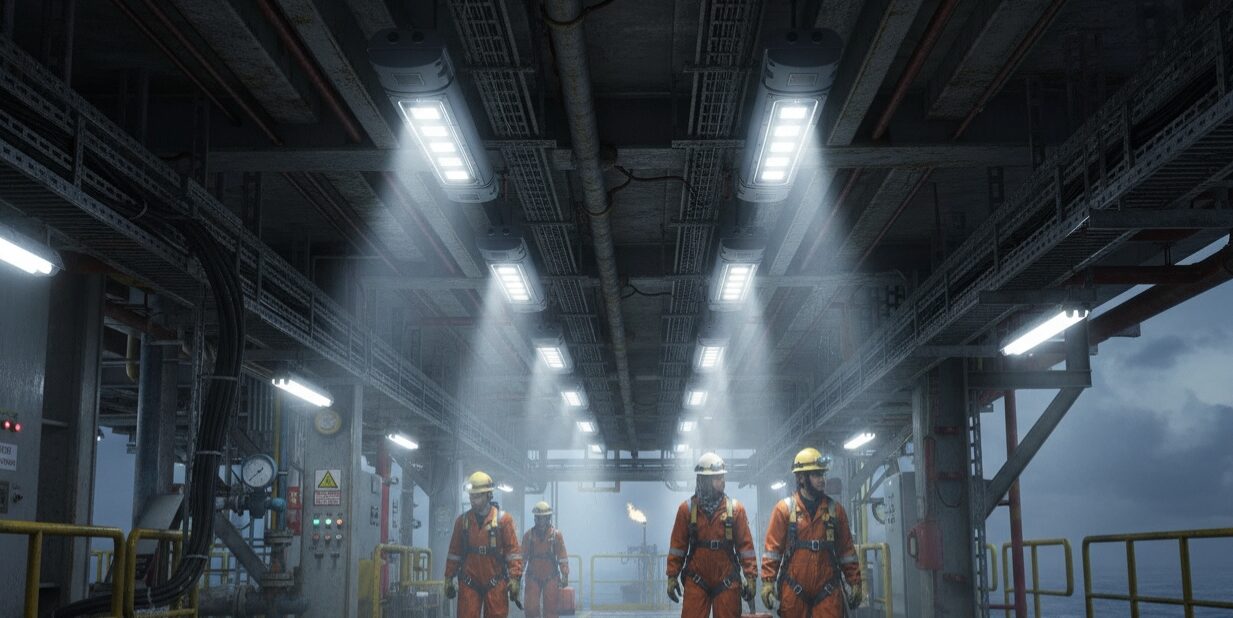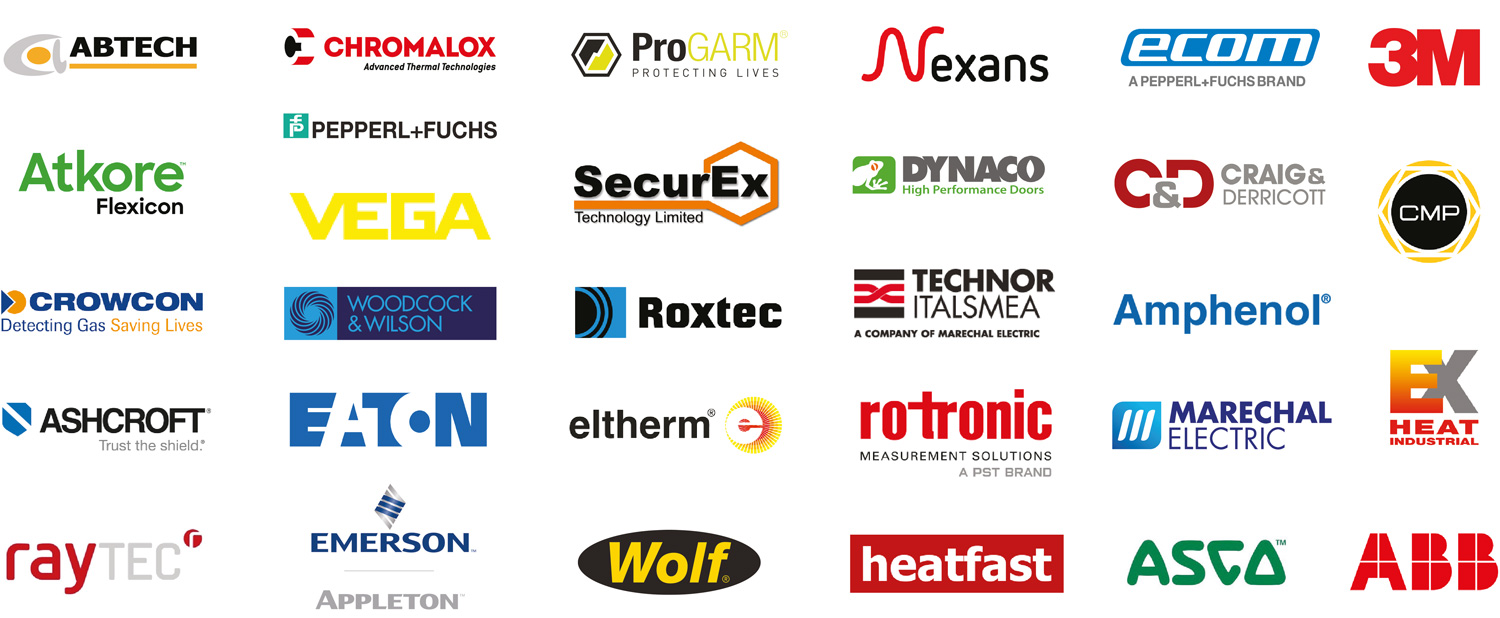A Complete Guide to ATEX Lighting Zones, Ratings & Certification
Published 16 Oct 2025
Safe, compliant lighting is essential where flammable gases, vapours or combustible dusts are present. This guide explains ATEX lighting zones, gas groups, temperature classifications (T-ratings), and the certifications you need to specify the correct explosion-protected luminaires. Whether you are a design engineer, safety manager, or site operator, this guide gives you the practical knowledge to choose, install and maintain ATEX lighting confidently.

Why ATEX Lighting Matters
Non-certified lighting can create ignition risks through electrical sparking, hot surfaces or degraded components. ATEX-certified luminaires are engineered to eliminate those risks — reducing the chance of explosion and ensuring regulatory compliance. In hazardous industries such as oil & gas, petrochemical, chemical processing, mining and grain handling, correct lighting specification is a safety-critical decision.
What is ATEX (and how it fits with IECEx & UKCA)?
ATEX is the common name for the European regulations covering equipment used in explosive atmospheres. The current EU regulatory framework derives from Directive 2014/34/EU. ATEX covers design, testing and marking of equipment for safe use in hazardous zones.
Related schemes include:
- IECEx – the international certification scheme under IEC standards, commonly used for global projects.
- UKCA – Compliancy with UK legislation and is a replacement for the CE marking for the UK market following the UK’s departure from the European Union.
![]()
Together these schemes ensure luminaires are tested and certified to operate safely in specific gas or dust hazards. When specifying lighting, confirm which certification(s) your project or jurisdiction requires.
ATEX Zones Explained (Gas & Dust)
ATEX uses a zone classification to express the likelihood and persistence of an explosive atmosphere. Knowing the correct zone is the first step in lighting specification.
Key point: Choose luminaires rated for the correct zone. A Zone 1 luminaire is suitable for Zone 1 locations but may not be necessary for Zone 2; conversely, using an under-rated luminaire is unsafe and non-compliant.
Need a full in-depth guide on ATEX Zones? See our Hazardous Zones, Definitions, & Explosion Protection Technical Guide.
Gas Groups & T-Ratings (Temperature Classes)
ATEX gas groups and temperature classes determine both the flammability properties of the atmosphere and the maximum surface temperature allowed for equipment.
Practical tip: Use conservative T-ratings in situations where combustible liquids or deposits can raise local surface temperatures or where dust layers could accumulate.
Types of ATEX Lighting
ATEX lighting comes in many form factors. Choose the style based on illumination needs, mounting, and zone classification.
- Floodlights Zone 1 & Zone 2 – for large external areas, yards and offshore decks.
- Linear LED fittings Zone 1 & Zone 2 – high bays, walkways, and process lines.
- Bulkheads Zone 1 & Zone 2 – general area lighting and ingress-protected locations.
- High Bay Zone 1 & Zone 2 – warehouses, hangars & hazardous workshops
- Emergency luminaires – maintained or non-maintained emergency options for safe egress.
- Portable & task lighting – certified hand-lamps and temporary lighting for maintenance.

Specifying ATEX Lighting: Key Considerations
Specification is about more than zone and certification. Use the checklist below to make a robust selection.
Installation, Inspection & Maintenance
Correct installation and ongoing inspection are vital to performance and safety.
- Competent personnel: Only qualified installers familiar with ATEX installations should work on hazardous areas.
- Cable glands & sealing: Use certified glands and ensure correct torque and sealing compounds to preserve enclosure integrity.
- Earthing & bonding: Proper earthing prevents static charge build-up and reduces ignition risk.
- Routine inspection: Scheduled visual inspections, lens cleaning, and checks of seals, glands and mounting hardware.
- Service logs: Maintain inspection and maintenance logs for compliance and traceability.
Common Mistakes to Avoid
- Incorrect zone selection: Specifying a lower rated luminaire for a higher risk zone is dangerous and non-compliant.
- Ignoring dust classifications: Treat dust hazards with equal rigour to gas hazards — they can be equally hazardous.
- Using non-serviceable fixtures: Non-serviceable units are harder to maintain and can be costlier over life cycle.
- Poor cable system installation: Sub-standard cable glands and routing undermine the luminaire’s protection.
ATEX Lighting FAQs
Q: What does ATEX stand for?
A: ATEX is derived from the French “ATmosphères EXplosibles”. It refers to EU directives and standards for equipment used in explosive atmospheres. The directive defines essential safety requirements for the design and testing of equipment used in hazardous areas.
Q: What is the difference between ATEX and IECEx?
A: ATEX is a European compliance system; IECEx is an international certification system administered by the IEC. Both ensure equipment meets safety standards, but IECEx is often used for global projects outside the EU while ATEX is essential for EU jurisdictions. Many manufacturers carry dual ATEX and IECEx certification.
Q: Can I use an ATEX light rated for Zone 2 in Zone 1?
A: No. A Zone 2 rated luminaire is designed for environments where an explosive atmosphere is unlikely under normal operation. Zone 1 locations are higher risk and require luminaires rated specifically for Zone 1. Always match or exceed the required zone rating.
Q: How often should ATEX lights be inspected?
A: Inspection frequency depends on site risk and operating conditions, but regular visual checks and a formal inspection at least annually are common. High-risk or outdoor corrosive environments may require more frequent checks. Follow manufacturer guidance and local regulations.
Conclusion & Next Steps
Specifying ATEX lighting demands a clear understanding of zones, gas groups, T-ratings and the installation environment. Use conservative assumptions when in doubt, prioritise serviceable, modular luminaires for easier maintenance, and ensure qualified personnel manage installation and inspection. If you need help confirming zones or selecting the correct luminaires for your site, our lighting specialists can provide site surveys, specification support, and ATEX-compliant product recommendations.

